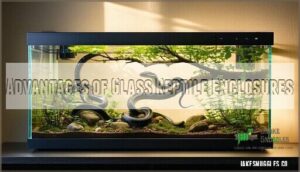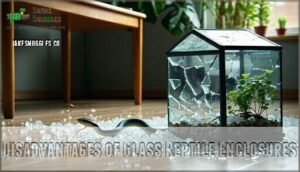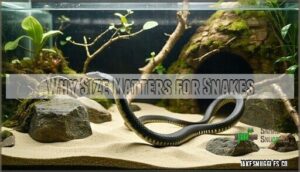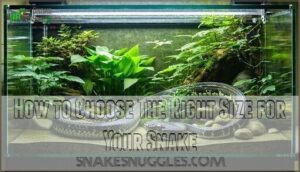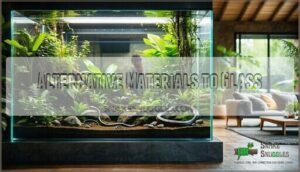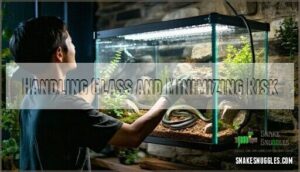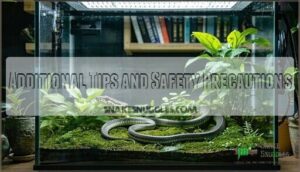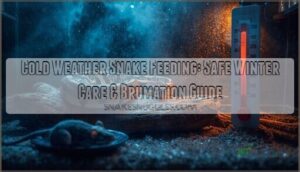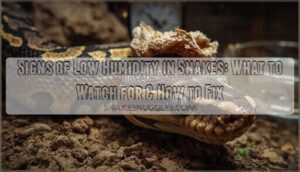This site is supported by our readers. We may earn a commission, at no cost to you, if you purchase through links.
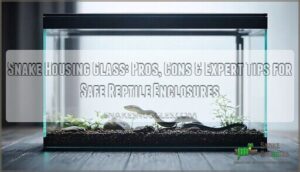
Glass offers great visibility, so you can admire those scales, but it’s not just about good looks.
Glass enclosures are durable and easy to clean, though you’ll need to keep a sharp eye on temperature and humidity; glass tends to lose heat faster than some other materials.
It can crack if dropped—a reminder that snakes and slippery hands don’t mix!
Choose secure lids to prevent escapes, and pick the right size to let your snake stretch out.
Want to boost your setup’s safety and comfort?
Table Of Contents
- Key Takeaways
- Choosing The Right Glass Enclosure
- Advantages of Glass Reptile Enclosures
- Disadvantages of Glass Reptile Enclosures
- Understanding Terrarium Sizes for Snakes
- Alternative Materials to Glass
- What Else You Need for Your Snake Enclosure
- Tips for Assembling and Maintaining a Glass Enclosure
- Additional Tips and Safety Precautions
- Frequently Asked Questions (FAQs)
- What is a good enclosure for a snake?
- What is snake housing?
- How do you keep a snake in a house?
- How do I bring a snake home?
- Do snakes need enclosures?
- How big should a snake enclosure be?
- How often should I replace the glass in my snake enclosure?
- Can snakes see their reflection in glass terrariums?
- What type of glass is safest for venomous snakes?
- How do I soundproof a glass snake enclosure?
- Conclusion
Key Takeaways
- Glass snake enclosures let you easily keep an eye on your snake and make cleaning simple, but you’ll need to carefully monitor temperature and humidity since glass loses heat fast.
- Always use tempered glass for safety—it’s tougher and less likely to shatter, giving your snake a secure place to live.
- Pick an enclosure big enough for your snake to stretch, move, and regulate body heat; tight spaces can stress and harm your pet.
- Secure lids and proper ventilation are must-haves to prevent escapes and keep your snake in a comfortable, healthy environment.
Choosing The Right Glass Enclosure
When you’re picking a glass enclosure for your snake, it’s not just about looks—factors like glass type, thickness, and safety all matter.
You don’t want your pet living in something flimsy, so let’s make sure you choose a setup that’s sturdy, secure, and easy to maintain (without needing a snake charmer on speed dial).
Types of Glass Used in Snake Enclosures
When picking glass terrariums or snake glass houses, you’ll often see tempered glass—tough, safe, and less likely to shatter.
Don’t overlook glass thickness; 6 mm (1/4 inch) is the sweet spot for stability.
Here’s a quick breakdown:
- Tempered Glass
- Annealed Glass
- Laminated Glass
- Insulated Glass
Choose wisely for a secure glass snake cage! Considering the reptile enclosure options is vital for the snake’s safety and well-being.
Pros and Cons of Glass Enclosures for Snakes
When you’re eyeing glass terrariums for your snake, it’s smart to weigh the pros and cons.
Glass snake cages look fantastic, resist stains, and make cleaning a breeze. On the flip side, they can be heavy, fragile, and sometimes pricey.
Here’s a quick breakdown:
| Pros | Cons |
|---|---|
| Visually appealing | Prone to breakage |
| Easy to clean | Can be expensive |
| Non-porous | Heavy to move |
| Durable surface | Less insulation |
| Customizable | Less privacy |
The table highlights the key points to consider, including the visually appealing nature of glass terrariums and their potential drawbacks.
Factors to Consider When Selecting a Glass Enclosure
Choosing a glass enclosure isn’t just about looks—it’s about smart science. You’ll want to weigh these essentials:
- Glass Thickness and Enclosure Materials: Thicker reptile glass boosts safety and durability.
- Ventilation Systems: Proper airflow keeps your snake healthy.
- Safety Features: Secure locks and childproofing prevent escapes.
- Snake Behavior: Some snakes prefer privacy, so consider glass terrariums versus glass snake cages.
When designing the enclosure, consider the importance of proper enclosure maintenance to guarantee a healthy environment for your snake.
Advantages of Glass Reptile Enclosures
When you choose a glass reptile enclosure, you get a clear view of your snake and a surface that’s easy to clean.
Glass enclosures let you watch your snake’s every move while making cleaning a total breeze.
Glass also stands up well to scratches and can last for years—unless, of course, you have a pet rock collection on the loose, which can be a clear problem, and impact the longevity of your glass enclosure.
Aesthetics and Visual Appeal of Glass Enclosures
Your snake’s home can be a real showstopper with the right Glass Design.
Sleek glass doors and radius corners boost Visual Impact, while Color Options and Texture Variety let you match any room.
Add background options or playful lighting effects for extra flair.
Glass enclosures offer unmatched visual appeal, turning your snake’s habitat into living art.
The quality of Glass Snake Enclosures substantially affects the overall aesthetic and safety of the reptile’s environment.
Durability and Long-Lasting Nature of Glass
Over the years, glass enclosures have proven their mettle in the reptile world. Tempered Glass, famous for its Glass Strength, stands up to daily use and the occasional bump—think of it as the heavyweight champ of snake vivariums.
Tempered glass is the heavyweight champ—built to handle bumps and years of reptile action without breaking a sweat.
Material Longevity and Durability Tests back up their reputation. Here’s why glass terrariums are tough competitors:
- Long-lasting material longevity—decades of use with care
- Scratch-resistant surfaces reduce Breakage Risk
- Tempered glass resists cracks under pressure
- Consistent durability for secure snake housing
Glass enclosures really go the distance! Glass offers great visibility, but acrylic provides superior impact resistance.
Easy Cleaning and Maintenance of Glass Enclosures
After appreciating the durability of glass, you’ll love how easy it’s to keep glass enclosures spotless.
With a simple reptile-safe cleaning product and a soft cloth, you’ll prevent scratches and keep your glass terrarium sparkling. For stubborn stains, try a vinegar soak or a bleach solution (1:10 ratio).
Good water quality and odor control go hand in hand with regular upkeep.
Here’s a quick guide:
| Task | Tool/Method | Frequency |
|---|---|---|
| Daily wipe | Damp cloth | Daily |
| Disinfecting | Bleach solution | Weekly |
| Stain Removal | Vinegar soak | As needed |
Regular maintenance is key to a healthy and thriving environment, and by following these simple steps, you can ensure your glass terrarium remains spotless and well-maintained.
Disadvantages of Glass Reptile Enclosures
While glass enclosures look great, you’ll need to watch out for issues like breakage, high cost, and temperature challenges.
Even the toughest glass can’t dodge a dropped rock or a curious pet, so it’s wise to know the risks before you commit.
Fragility and Breakage Risks of Glass
While glass enclosures look sharp and are scratch-resistant, their fragility is no joke.
Glass shattering isn’t rare—especially if you skip basic breakage prevention or ignore risk assessment.
Always use tempered glass and take extra safety measures. Remember, fragile materials need respect.
Try these tips:
- Cushion corners and edges
- Childproof the enclosure area
- Handle with two hands
Cost Considerations of Glass Reptile Enclosures
When planning your Enclosure Budget, don’t let Glass Prices sneak up on you.
While glass enclosures look sharp, Material Costs, Installation Fees, and Maintenance Expenses add up fast.
Even a budget-friendly model can get pricey once you factor in longterm costs.
Weigh the affordable price point of alternatives before committing—sometimes the shiniest option isn’t the most practical.
Heat and Light Distribution Limitations
A key challenge with glass enclosures is managing heat and light.
Thicker glass can block radiant heating, making heat distribution tricky. UVB penetration isn’t always even, so your snake might miss out on essential rays.
To create proper thermal gradients and light diffusion, focus on:
- Strategic heat lamp placement
- Careful heat mapping
- Consistent temperature control
- Monitoring UVB exposure to ensure your snake receives the necessary amount of UVB and maintains a healthy environment with proper thermal gradients.
Understanding Terrarium Sizes for Snakes
Choosing the right terrarium size for your snake keeps your pet healthy and reduces stress, much like picking the right shoe size for yourself.
If you go too small or too large, your snake might end up more confused than a gecko at a glass factory.
Why Size Matters for Snakes
In the context of Snake Space, bigger is better.
A cramped habitat restricts movement and natural behaviors, much like living in a closet.
Proper tank dimensions and Enclosure Depth let your snake stretch, explore, and regulate temperature.
If the snake enclosure size doesn’t match your pet’s adult size and growth rate, health and longevity can suffer—choose wisely!
How to Choose The Right Size for Your Snake
Think of Snake Length as your measuring stick—tank dimensions should match or exceed it for stretching and exploring.
Don’t forget Enclosure Depth; shallow tanks cramp style.
Factor in growth rate and adult size, so you’re not upgrading every season.
A roomy snake housing glass setup lets you manage Substrate Volume and enrich your snake’s life without breaking a sweat.
Space Considerations for Temperature and Humidity
A well-sized enclosure is your snake’s climate command center. Space isn’t just for slithering—it’s for managing Temperature Control, Humidity Levels, and Ventilation Systems.
Here’s what you need to nail:
- Guarantee proper airflow for healthy ventilation and moisture management.
- Create heat gradients—warm on one side, cool on the other—for effective heat distribution.
- Monitor humidity levels so your snake enjoys balanced moisture and stable temperature zones.
No sauna or desert mishaps, as managing these elements is crucial for your snake’s health, and a well-designed enclosure will help you achieve the perfect balance of Temperature Control, Humidity Levels, and ventilation to create a comfortable environment for your pet.
Alternative Materials to Glass
If you’re worried about glass breaking or just tired of moving heavy tanks, you’ll find several sturdy alternatives like acrylic, HDPE, and PVC.
These materials offer unique benefits for snake enclosures, making your reptile’s home safer and your life a little easier—no superhero strength required, with benefits like acrylic.
Acrylic Reptile Enclosures and Their Pros
If you’re weighing glass vs acrylic for your next snake terrarium, acrylic enclosures shine for their lightweight feel and shatterproof safety.
These reptile enclosures offer crystal-clear views, making animal comfort and Reptile Safety top priorities.
Acrylic Benefits include easy cleaning, strong Enclosure Design, and lower Material Costs—perfect if you want a sturdy, budget-friendly home that won’t break the bank or your back.
When considering enclosure materials, the use of acrylic snake options can provide a safe and healthy environment for your pet.
One-piece HDPE Reptile Enclosures and Their Pros
If acrylic enclosures caught your eye, wait until you see the HDPE benefits. One-piece HDPE enclosures offer impressive material durability, space efficiency, and easy cleaning.
Their seamless enclosure design means fewer spots for bacteria to hide, boosting reptile safety.
Here’s why keepers love them:
- No more tough cleaning battles
- Stable temps—snake comfort guaranteed
- Compact, stackable reptile housing
PVC Panel Reptile Enclosures and Their Pros
If you’re after a smart balance of price and performance, PVC panel reptile enclosures are tough to beat.
PVC Benefits include lightweight construction, strong panel durability, and easy assembly—no wrestling with heavy glass reptile tanks.
These enclosures offer excellent reptile safety and modern enclosure design without high material costs, making them a top choice for practical snake enclosures.
What Else You Need for Your Snake Enclosure
A glass enclosure is just the start—you’ll need to manage lighting, heating, humidity, and bedding to keep your snake healthy.
If you forget the right setup, your snake might give you the cold shoulder (and that’s not just a reptile joke).
Lighting and Heating Options for Snakes
After exploring alternative materials, let’s shed some light on heating and lighting. Snakes thrive with the right mix of Heat Lamps, UVB Lighting, and Thermal Mats.
Pairing heat sources with thermostat control keeps things safe. Lighting cycles mimic nature, supporting healthy rhythms.
Here’s what you’ll need:
- UVB bulbs
- Heat lamps
- Thermal mats
- Basking lights
- Thermostat control
Proper UVB lighting requires understanding UVB bulb options to create a suitable environment.
Humidity and Temperature Control for Snakes
After sorting out lighting and heating, let’s talk humidity and temperature control—your snake’s comfort zone.
Here’s how to keep things just right:
- Monitor Humidity Levels: Most snakes thrive between 30–60%—invest in a hygrometer.
- Build Temperature Gradients: Use heat sources to create warm and cool zones.
- Use Ventilation Systems: Proper airflow prevents mold and supports healthy thermal cycles.
Maintaining vital humidity is essential, and understanding humidity control strategies helps prevent health issues in snakes.
Bedding and Substrate Options for Snakes
Once your humidity and temperature are steady, it’s time to pick the right Snake Bedding.
Substrate Materials like aspen bedding or cypress mulch help with Humidity Control and let your snake burrow naturally.
Reptile carpet is easy to clean, but skip sand options—gravel and sand can cause health issues.
Here’s a quick comparison:
| Substrate | Pros |
|---|---|
| Aspen Bedding | Great for burrowing, dry |
| Cypress Mulch | Holds moisture, natural |
| Reptile Carpet | Easy cleaning, reusable |
| Sand Options | Risk of impaction, avoid |
| Paper Towels | Cheap, simple, not natural |
Tips for Assembling and Maintaining a Glass Enclosure
When you set up and care for a glass snake enclosure, you’ll need to pay close attention to details like cleaning, assembly, and safe handling.
If you’ve ever tried moving a glass tank without help, you know it’s not a job for butterfingers—precision and patience keep both you and your snake safe.
Setting Up Your Glass Enclosure for The First Time
Once you’ve chosen your snake enclosure and gathered supplies, focus on Glass Placement and Enclosure Design.
Set the glass terrarium on a sturdy, level surface away from drafts or direct sun.
Check all seals and locks for safety. Add hides and décor to match your snake’s habitat preferences.
This First Setup helps with snake acclimation and makes Glass Care easier down the road.
How to Keep Your Glass Enclosure Clean and Fresh
After setup, keeping your glass enclosure clean is like tuning a guitar—routine makes everything work better.
Use reptile-safe Cleaning Products and a soft cloth for an easy to clean, secure environment.
Try these cleaning tips:
- Wipe glass weekly for Fresh Air.
- Change water daily for Water Quality.
- Monitor Humidity Control.
- Rotate Sanitizing Methods for best disinfecting method.
Handling Glass and Minimizing Risk
Anyone who’s moved a glass enclosure knows it’s like handling a sleeping dragon—one wrong move and things get dicey. For exceptional Glass Safety and Injury Avoidance, always use two hands and lift from the bottom.
Assess the risk before moving, and never carry large panels alone. Place your snake’s home on a stable surface to avoid breakage risks.
Use reptile-safe cleaners and soft cloths to keep things spotless.
- Wear cut-resistant gloves for extra handling glass protection
- Avoid high-traffic zones for escape prevention
- Check for chips or cracks before use
- Secure all locks for a truly safe snake
Additional Tips and Safety Precautions
You’ll want to keep both your snake and yourself safe when working with glass enclosures, since even the most careful owners can have a slippery moment.
By following a few extra safety steps, you can prevent escapes, avoid breakage, and make sure your snake’s home doesn’t turn into an accidental game of hide-and-seek.
Safety Considerations for Snakes and Humans
After assembling your snake enclosure, safety should stay front and center.
Glass breakage can cause human injury or harm your snake, so always handle panels with care.
Guard against thermal burns and electrical shock by checking heating devices and cords.
Childproofing your setup adds another layer of escape prevention.
Prioritize a secure environment—your snake will thank you, and your fingers will too!
Ways to Prevent Breakage and Escape
Peace of mind starts with Snake Safety—always use tempered glass for Breakage Prevention and reinforce weak spots for added Glass Reinforcement.
Invest in Secure Lids and check all locks after cleaning or feeding.
Double-check for gaps; snakes are masters of Escape Proofing.
Keep your glass cages away from high-traffic areas.
With an escapeproof setup, your snake enclosures become a truly secure environment.
Recommendations for Stacking and Combining Cages
Stacking cages into a “snake skyscraper” is smart vertical storage, but don’t let your ambitions topple.
Use sturdy modular designs for stable multi level setups. Each combined enclosure needs solid support and proper ventilation—nobody likes a stuffy elevator.
Evenly distribute heat across glass enclosures for safe snake enclosure design. With careful cage stacking, you’ll expand reptile enclosure options while keeping escape artists grounded.
Proper ventilation requires understanding of secure cage designs to guarantee a healthy environment and support secure cage setups.
Frequently Asked Questions (FAQs)
What is a good enclosure for a snake?
Because snakes obviously requested posh digs, go for a secure, escape-proof enclosure—think thick walls, tight lids, and good airflow.
Plastic, PVC, or acrylic cages excel for stress reduction, temperature control, and snake well-being.
Avoid fancy wallpaper—your snake won’t care.
What is snake housing?
Snake housing means creating a safe space where your snake can eat, rest, and explore.
You’ll need to take into account temperature, humidity, security, and privacy—think of it like designing a cozy studio apartment for your reptile roommate.
How do you keep a snake in a house?
You’ll need a secure, escape-proof enclosure with proper heating, humidity, and hiding spots.
Feed regularly, clean often, and check for gaps—because a snake’s idea of home improvement usually means finding the nearest exit!
How do I bring a snake home?
Think of it like moving a delicate vase—secure your snake in a ventilated travel container, keep it out of direct sun, and avoid sudden jolts.
Once home, let it settle quietly in its prepared enclosure.
Do snakes need enclosures?
You’ll want to give your snake an enclosure for its own safety and comfort.
Without one, it’s like letting your pet goldfish roam the living room—exciting at first, but chaos (and escape) quickly follows.
How big should a snake enclosure be?
Don’t put all your eggs in one basket—size matters.
Aim for an enclosure at least as long as your snake and half as wide.
This gives your buddy room to stretch, thermoregulate, and explore without feeling boxed in.
How often should I replace the glass in my snake enclosure?
Replace the glass only if it’s cracked, chipped, or foggy beyond cleaning.
Tempered glass can last decades with care.
If your snake’s enclosure starts looking like a windshield after a hailstorm, it’s time for new glass.
Can snakes see their reflection in glass terrariums?
Staring, gliding, pausing—snakes can’t recognize their reflection in glass.
Instead, the shiny surface tricks them, leading to confusion and glass surfing.
Imagine your snake as a little explorer mistaking its own face for another visitor, which can lead to glass surfing.
What type of glass is safest for venomous snakes?
Tempered glass takes the prize for safety when housing venomous snakes.
It’s super strong, resists shattering, and can handle a few knocks.
You’ll rest easy knowing a sudden head-butt won’t turn into an escape plan!
How do I soundproof a glass snake enclosure?
Ever notice every little sound echoing through glass like gossip at a coffee shop?
You’ll want foam panels, silicone seals, and a heavy enclosure cover.
They’ll hush vibrations and calm your snake—and your nerves—nicely.
Conclusion
Glass enclosures offer clarity and durability, but you’ll juggle fastidious monitoring of heat and humidity—snake housing glass isn’t all crystal-clear luxury.
Factor in secure lids and breakage risks before making your pick.
A glass terrarium makes maintenance a breeze, yet demands technical care to keep your pet thriving.
Choose wisely, and you’ll give your snake a safe and visible home that’s both practical and attractive.
Go ahead—turn your living room into a reptile penthouse, minus surprise escapes!
- https://www.pbspettravel.co.uk/blog/snake-vivariums-what-are-the-options/
- https://www.visionproducts.us/products/categories/vision-cages/
- http://kpexotics.com/Main/2020/10/12/modifying-a-glass-tank-for-a-ball-python/
- https://www.youtube.com/watch?v=p0_lcfud2HA
- https://community.morphmarket.com/t/humidity-and-heat-in-glass-enclosure-albino-python-eating-issues/38152

